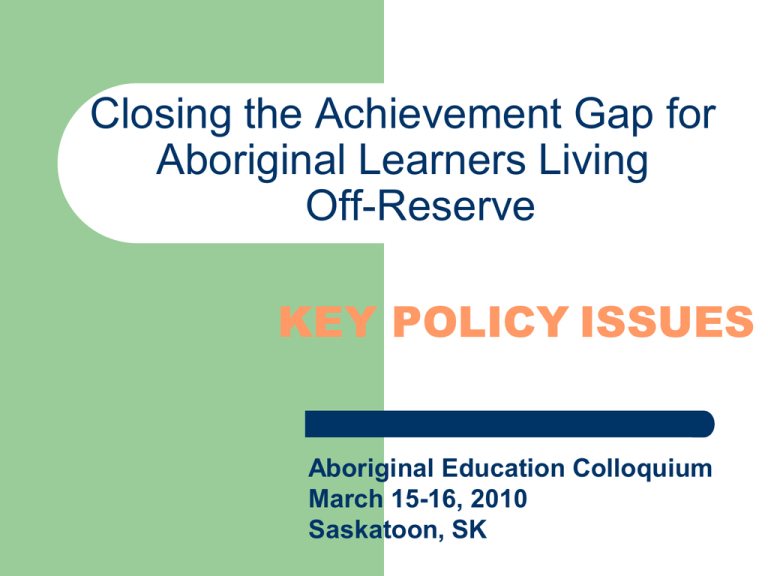Closing the Achievement Gap for Aboriginal Learners Living Off-Reserve KEY POLICY ISSUES
advertisement

Closing the Achievement Gap for Aboriginal Learners Living Off-Reserve KEY POLICY ISSUES Aboriginal Education Colloquium March 15-16, 2010 Saskatoon, SK CHALLENGES TO RATIONAL POLICY MAKING • Tangle of education governance • Absence of coherent data on how existing policies are working • Complexity of teaching and learning and the many variables in delivery and context that influence student success The Big Question How do we identify policies with the most potential for leveraging largescale progress for aboriginal students? Strategic Approach Focus on key domains influencing outcomes for aboriginal learners Develop policies in each domain to scale up best practice based on research evidence Implies a multi-dimensional approach to policy – no single magic bullet Key Domains that Influence Results for Aboriginal Students Literacy & language instruction Cultural relevancy Engagement and retention Parent/community involvement Teacher quality School leadership School programming Assessment and monitoring #1 LITERACY AND LANGUAGE Strong literacy skills are the foundation of academic success and a key predictor of high school graduation. How are we doing? In BC, 37% of aboriginal students in Grade 7 are Not Yet Meeting Expectations on provincial assessments of reading. BC Aboriginal Education Branch, 2008 In Saskatchewan, 24% of self-declared aboriginal students in Grade 7 are Proficient in overall reading comprehension. Saskatchewan Education Indicators Report, 2009 Language program evaluation “The Cree Language of Instruction Program has done a poor job of teaching Cree as a language and completely failed to provide a language of instruction for learning. An entire generation of students has passed through this regime and are failing in record numbers.” Report commissioned by Cree School Board, 2008 (Quebec) What we know Language of Instruction With skilled instruction, aboriginal children can learn to read well in either their first or second language. Their literacy growth is more rapid if taught to read in their first language. Children taught in their second language experience delays in both languages. Bilingual programs advantage students if wellimplemented. Transfer to instruction in the second language should be delayed 5-6 years. Goosney & O’Sullivan, 2007 What we know Teacher Expertise Teacher knowledge of when and how to apply appropriate reading strategies is a crucial factor in reading acquisition, especially for at-risk students. Reading must be expertly taught across the curriculum at all levels. This requires specific training in interventions to bridge literacy gaps. Children whose teachers receive literacy coaching make greater reading gains. Bilingual program teachers require highly specialized training in language acquisition and transfer. Implications for Policy Make literacy a priority for all aboriginal students. Invest heavily in teacher training, staff development, school-based literacy coaches. Create the conditions for success in delivering quality aboriginal language programs: the development of a supply of proficient teachers, rigorous and engaging curriculum and resources, reliable assessments, and diagnostic tools. Institute monitoring systems to evaluate the quality of literacy programs, and report on the progress of the aboriginal cohort. #2 CULTURALLY BASED INSTRUCTION A strong cultural identity is a consistent factor in aboriginal student success. School connectedness is an antidote to dropping out. For aboriginal students, connectedness is achieved through a school environment and curriculum which reflects and honours their culture. Does Culturally Based Education Work? A three-year initiative infusing the math curriculum with indigenous knowledge and concepts for 20,000 Grade 8 Native Alaskan students increased the percentage of these students achieving in the top quartile on state assessments, and reduced the percentage in the lowest quartile. (Demmert, 2003) This has policy implications for Curriculum development and resources Pedagogical approaches Teacher training, induction and professional development Assessment The role of aboriginal communities in the education process #3 ENGAGEMENT & RETENTION The high school graduation rate for Canada’s aboriginal cohort is 28% below the national average. What do we know? Dropping out is preventable. It is most often related to in-school conditions that we can control: Lack of supportive relationships Weak instructional and support services Perceived irrelevance of curriculum Poor attendance and behavior Widening skills & knowledge gap Low parental involvement Attendance and transitions matter Attendance is strongly associated with school completion. The odds of dropping out increase 30% each time vulnerable youth change schools. Programs make a difference Access to technology, vocational and apprenticeship programs, and career counselling improves aboriginal graduation rates. Policies to Promote Retention Reduce high mobility rates in urban areas. Supply comprehensive in-school supports including tutoring, homework clubs buddy systems, elder programs, counselling, home outreach, attendance interventions. Strengthen school-connectedness through caring staff, native culture, motivating instruction, extra-curricular activities, family involvement. Expand career programming. #4 HOME AND COMMUNITY INVOLVEMENT Engaging family and local community in indigenous education is vital if there is to be a significant shift towards equality of educational outcomes. Commonwealth of Australia, 2007 What does the research say? Families play a vital role in influencing children’s learning and school success. Benefits are strongest when school/family partnerships focus directly on promoting children’s learning and engagement. Participatory decision-making is associated with higher performance Evidence of the challenge: Only 14% of teachers and staff recently surveyed by the Cree School Board in Quebec agreed with the statement: “Parents participate in their children’s learning.” Cree School Board Report (2008). Policies to Promote Involvement Expand school-based parenting programs focused on building capacity to support children’s learning Establish formal structures for participation in decision-making; supplement with informal ways Encourage involvement in development and delivery of local cultural curriculum Australian strategies Local Aboriginal Education Agreements (BC) #5 TEACHER QUALITY Pedagogy is the critical variable in improving achievement for at-risk populations. (Alton-Lee, 2003) Pedagogy is the crucial element for aboriginal learners: the organization of learning and teacher-student relationships. (Tharp, 2006) Teacher expertise has powerful effects (3x) on student learning. (McKinsey, 2007) Current State of Affairs There is a shortage of highly qualified teachers for aboriginal classrooms. There has been little evaluation of the efficacy of aboriginal or mainstream teacher preparation programs in meeting the needs of aboriginal learners. Few comprehensive induction and mentoring programs exist to support new teachers. Professional Development Matters Sustained school-embedded professional development is needed to change classroom practice; under 40 hours has no positive impact on student achievement (Yoon, 2007). Australian teachers receiving intensive training in literacy strategies produced higher literacy outcomes than teachers in control classes who did not receive this training (Phillips, 2002). A 2-year intervention providing intensive coaching in instructional strategies produced dramatic literacy & numeracy gains for aboriginal learners at Mount Carmel School (Fulford, 2007). Mount Carmel Results 2003 2006 Grade 3 students at or above provincial standards in: Reading Numeracy 10% 10% 47% 82% Grade 6 students at or above provincial standards in: Reading 21% 65% Numeracy 31% 62% Policy Implications for Teacher supply and initial training Hiring practices Teacher induction and mentoring programs Amount and forms of professional development #6 SCHOOL LEADERSHIP Mainstream and aboriginal research identify leadership as the most important factor in school effectiveness in raising achievement. There is a shortage of highly qualified aboriginal principals in Canada. Little specialized training or professional development is available for principals in schools serving FNMI students. Policy Implications: Attention to recruitment strategies. Systematic delivery of the specialized training and on-going professional development required for all principals serving aboriginal learners. Possibilities include establishing regional FNMI School Leadership Academies, recognized credentialing for salary, and a national network for principals in aboriginal schools. What do we know? #7 SCHOOL PROGRAMMING Aboriginal learners benefit from more seamless and holistic programming. A broader range of supports and services is required to facilitate their academic success. This programming is enhanced by the participation of aboriginal educators, support staff, elders and community. Evidence on richer programming Community schools have been shown to reduce negative behaviors in at-risk youth and have positive effects on their attendance, achievement, and family involvement at school. Blank, Melville and Shaw, 2005 Some Implications for Policy Invest in community schools to address aboriginal learners’ needs more holistically. Integrate quality early learning programs and career/apprenticeship training with the K-12 program. Increase the supply of aboriginal staff in program delivery. Give schools the flexibility and authority to develop programs to meet local conditions. #8 ASSESSMENT Effective classroom assessment improves learning, with larger effects for struggling students. Teacher proficiency in the use of assessment is a key factor in the progress of aboriginal students. Schools benefit from coaching in the analysis of data for school-wide improvement planning. Few reliable assessments of aboriginal languages and indigenous knowledge have been developed. There is no pan-Canadian set of indicators for reporting on progress of the aboriginal cohort. Policy Implications Strengthen classroom and school expertise in the use of assessment to improve learning. Develop broader measures of FNMI learning. Strengthen the collection of performance data relative to the larger population to guide improvement efforts. Report progress annually at school, district, province and national level. Conduct regular program evaluations at all levels. SUMMARY A coordinated approach to education policy that addresses in tandem these eight key areas of delivery known to influence aboriginal student outcomes is the most effective strategy for improving their performance. Helen Raham Kelowna, BC hraham@uniserve.com 250.860.7948







